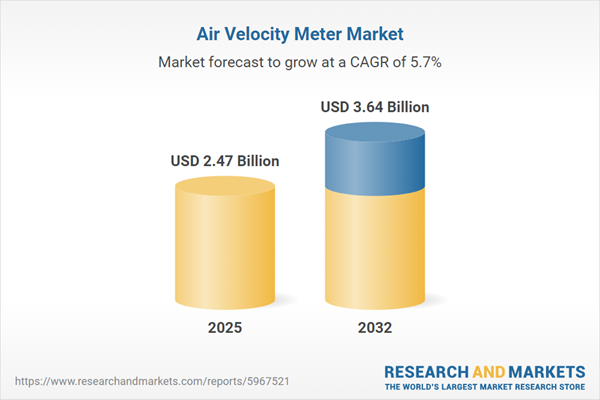Speak directly to the analyst to clarify any post sales queries you may have.
As industries worldwide modernize facilities and pursue environmental accountability, demand for reliable airflow measurement and monitoring has become integral across sectors. The air velocity meter market is advancing to meet these needs with broader applications and technologically diverse solutions positioned to drive decision-making, safety, and compliance.
Market Snapshot: Air Velocity Meter Market Size and Trajectory
The air velocity meter market grew from USD 2.33 billion in 2024 to USD 2.47 billion in 2025, and forecasts indicate continued robust expansion at a CAGR of 5.70%, reaching USD 3.64 billion by 2032. This trajectory reflects widespread adoption across manufacturing, research, and environmental monitoring sectors. Investment in compliance, precision, and facility optimization has elevated air velocity metering from process support to a critical operational asset.
Scope & Segmentation
This report provides a comprehensive breakdown of the air velocity meter landscape, evaluating technology adoption, end-user preferences, and regional disparities. Current and emerging solutions are covered exhaustively for decision-makers considering procurement, investment, or strategic partnerships.
- Technology Types: Laser Doppler, Pitot Tube, Thermal (Hot-Film, Hot-Wire), Ultrasonic, Vane anemometers
- Applications: Aerospace, Automotive Testing, HVAC (Commercial, Residential), Industrial Process Control (Chemical, Food & Beverages, Petrochemical, Pharmaceuticals), Meteorology
- End Users: Commercial Buildings, Data Centers, Manufacturing, Energy & Power, Oil & Gas, Research Institutions, Residential
- Portability Options: Fixed, Portable
- Sales Channels: Direct Sales, Distributors, Online Retail
- Regions: Americas (North America, Latin America), Europe, Middle East & Africa, Asia-Pacific
The segmentation approach addresses the full breadth of industrial and building environments, ensuring high relevance for leaders assessing entry or expansion points within this market.
Key Takeaways for Decision-Makers
- Technological innovation, including wireless telemetry, data analytics, and integrated sensor networks, is steadily redefining market expectations for air velocity measurement precision and flexibility.
- Industry adoption patterns are increasingly shaped by regulatory requirements and energy management priorities, particularly within HVAC and controlled industrial environments.
- End-user demands for modularity, real-time monitoring, and data-driven insight are pushing vendors to deliver interoperable and upgrade-ready sensor solutions for both fixed and portable applications.
- Ruggedized sensor designs and advanced materials are enabling broader use in harsh industrial environments, from high-temperature manufacturing to petrochemical operations.
- Emerging applications in environmental and agricultural monitoring are expanding addressable market segments and introducing new channels for value creation.
Tariff Impact and Supply Chain Adaptation
Recent US tariff regimes have directly influenced supply chain strategies for global air velocity meter providers. Many manufacturers are responding with localized supplier partnerships, regional assembly, and diversified sourcing. Such changes affect time-to-market, cost structures, and regional market entry strategies. Subscription models and bundled service offerings are emerging as ways to offset increased component costs and create recurring revenue.
Air Velocity Meter Market Methodology & Data Sources
Rigorous analytical processes underpin all findings. Primary research included interviews and surveys with industry executives, end users, and distributors. Secondary sources comprised technical publications, standards, company reports, and regulatory databases. Data triangulation and expert validation ensured robust, actionable insight.
Why This Report Matters: Executive Value
- Enables senior leaders to align product or procurement strategies with current technology, market, and supply chain realities.
- Supports risk mitigation and opportunity identification through regional, sectoral, and channel-specific analysis.
- Equips stakeholders to make informed decisions on investments, product differentiation, and global expansion based on multi-source, validated data.
Conclusion
The air velocity meter market is entering a phase of adaptive, data-driven growth defined by advanced sensing, regulatory alignment, and strategic supply chain evolution. Leaders prepared to act on these insights will be positioned to secure long-term competitive advantage across diverse industries and geographies.
Additional Product Information:
- Purchase of this report includes 1 year online access with quarterly updates.
- This report can be updated on request. Please contact our Customer Experience team using the Ask a Question widget on our website.
Table of Contents
3. Executive Summary
4. Market Overview
7. Cumulative Impact of Artificial Intelligence 2025
Companies Mentioned
The companies profiled in this Air Velocity Meter market report include:- Testo SE & Co. KGaA
- TSI Incorporated
- Fluke Corporation
- Kanomax Japan, Inc.
- FLIR Systems, Inc.
- Dwyer Instruments, Inc.
- Omega Engineering, Inc.
- Nielsen-Kellerman Company, Inc.
- AHLBORN GmbH
- Airflow Developments Ltd
Table Information
| Report Attribute | Details |
|---|---|
| No. of Pages | 199 |
| Published | October 2025 |
| Forecast Period | 2025 - 2032 |
| Estimated Market Value ( USD | $ 2.47 Billion |
| Forecasted Market Value ( USD | $ 3.64 Billion |
| Compound Annual Growth Rate | 5.7% |
| Regions Covered | Global |
| No. of Companies Mentioned | 11 |









